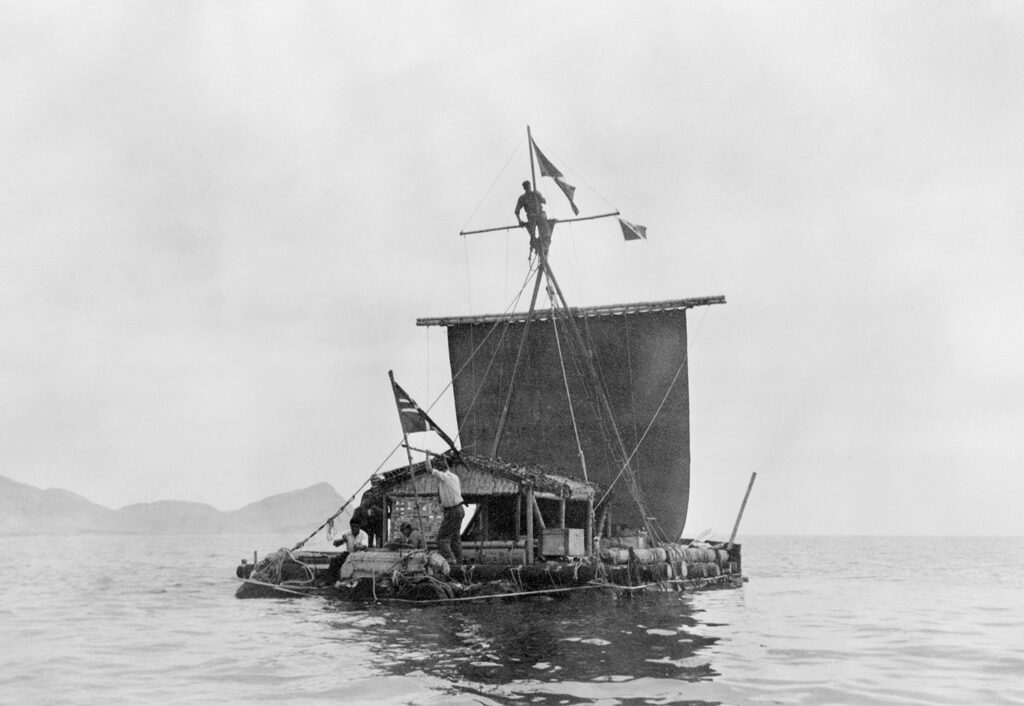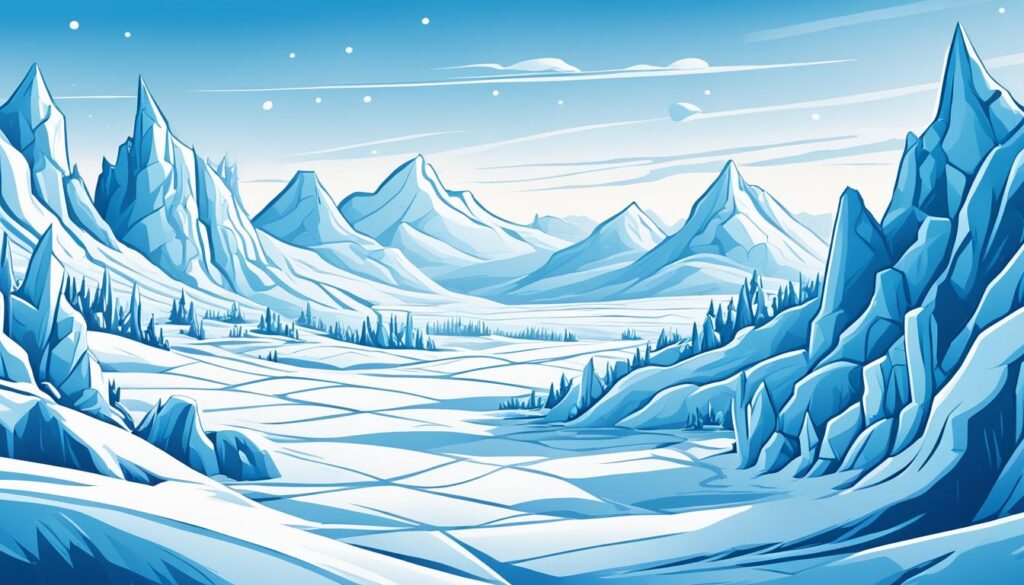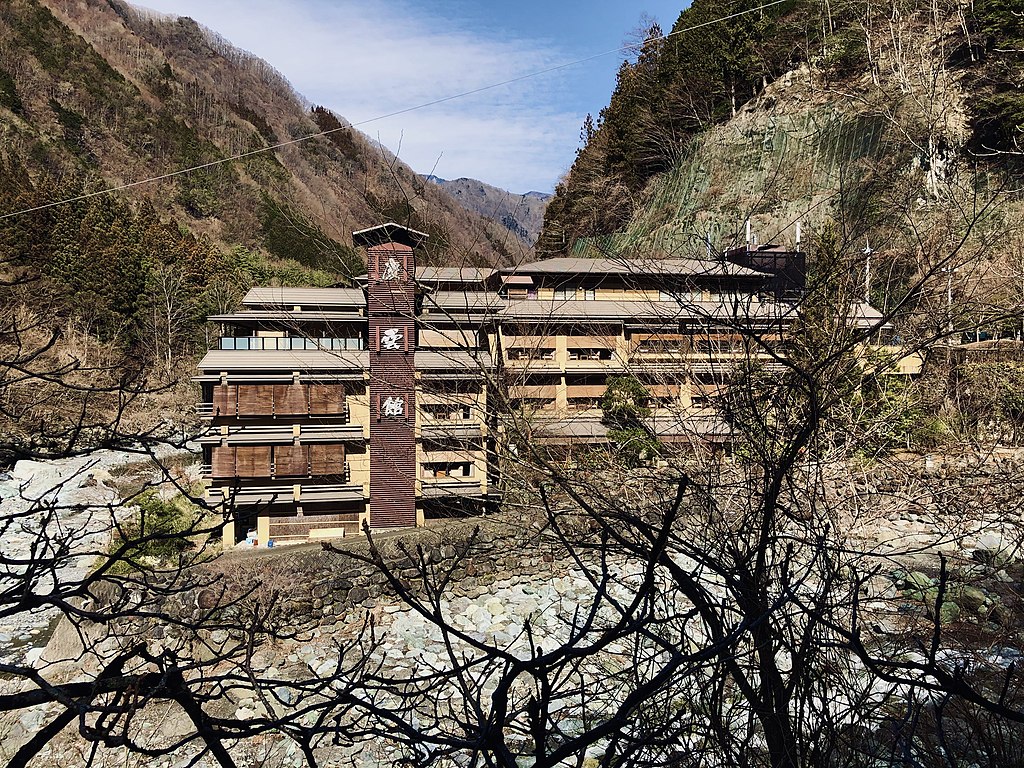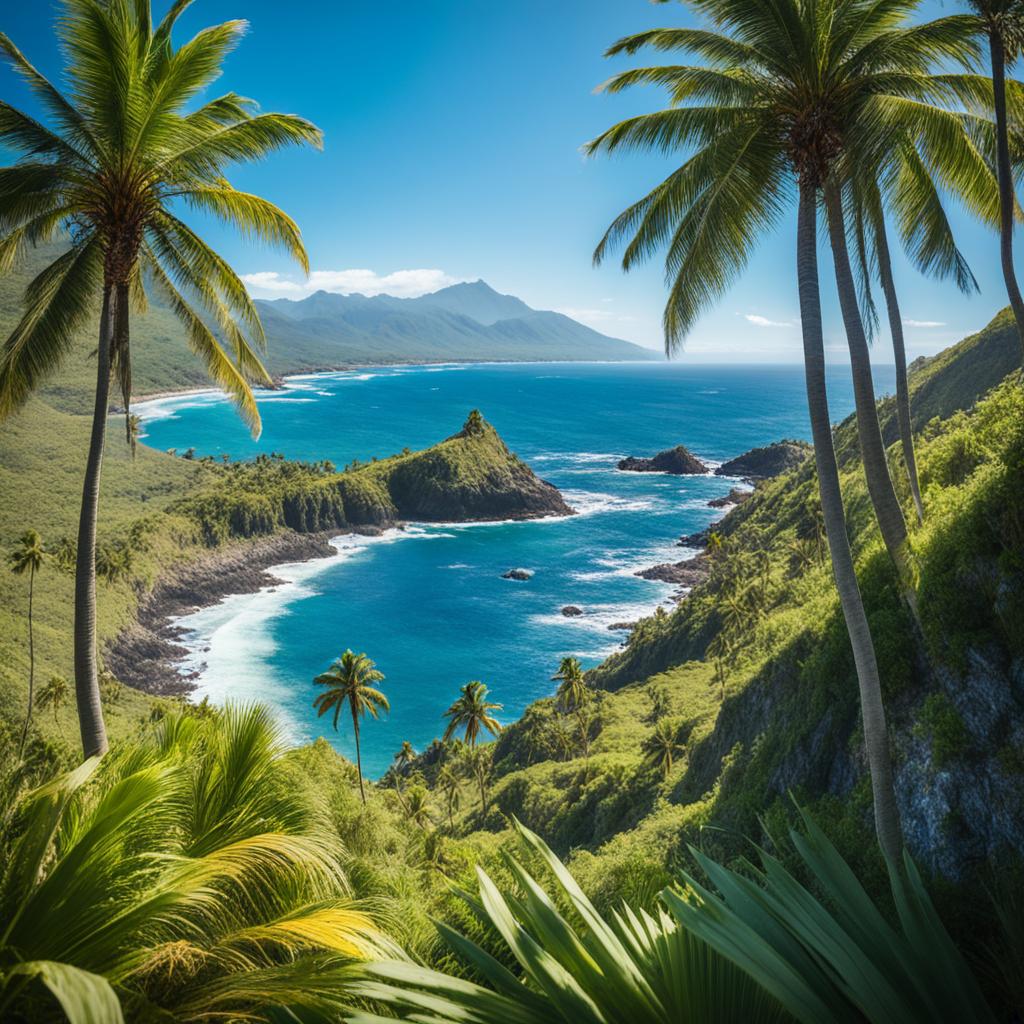Have you ever wondered if ancient civilizations possessed seafaring knowledge beyond what we previously believed? Can a balsa wood raft truly withstand the challenges of the deep, vast Pacific Ocean? Prepare to be amazed as we embark on the incredible journey known as The Voyage of the Kon-Tiki. Join a group of fearless adventurers as they set out to prove ancient theories, challenging our understanding of Polynesian migration and South Pacific exploration.

Key Takeaways:
- The Voyage of the Kon-Tiki was a daring expedition that aimed to prove ancient theories of seafaring.
- Thor Heyerdahl, the leader of the expedition, sought to retrace Polynesian journeys and unravel the mysteries of their migration.
- The construction and design of the Kon-Tiki raft showcased the remarkable skills of ancient Polynesians.
- The expedition encountered thrilling adventures and faced treacherous challenges in the South Pacific.
- The legacy of the Kon-Tiki expedition continues to inspire future explorations in anthropology and adventure travel.
The Kon-Tiki Expedition
Embark on a thrilling adventure as we dive deep into the remarkable Kon-Tiki Expedition led by Thor Heyerdahl, the intrepid Norwegian ethnographer and adventurer. This daring undertaking took place in 1947 when Heyerdahl and his team set out to prove that ancient civilizations were capable of long-distance oceanic travel.
Driven by a burning curiosity and a desire to challenge mainstream theories, Heyerdahl devised a audacious plan to construct a balsa wood raft and sail it across the vast Pacific Ocean. Far from reaching consensus among the scientific community, Heyerdahl believed that Polynesian migration originated from South America, contrary to popular belief at the time.
Adventurous travelers and eager to push the boundaries of exploration, Heyerdahl and his multinational crew embarked on a journey fraught with uncertainty and danger. The Kon-Tiki Expedition would test their mettle and provide invaluable insights into the capabilities of ancient civilizations.
As they set sail from Peru, braving treacherous waves and unpredictable weather, the crew faced various challenges, ranging from navigational issues to resource scarcity. Their primitive vessel, constructed with careful attention to ancient techniques, showcased the resilience and ingenuity of early seafarers.
“The Pacific, an enormous spiral of blue infinity, beckoned us with countless mysterious islands and tempting mainland shores. Countless centuries lay between now and when our early ancestors first ventured across parts of this vast seascape,” says Heyerdahl. “The aim of the Kon-Tiki Expedition is to show that the voyage was technically possible with the means available to those early departures from South America.”
The Kon-Tiki Expedition captured the imagination of the world and catapulted Heyerdahl to international fame. His audacious journey not only challenged conventional wisdom but also paved the way for further exploration and understanding of our ancient past.
The Challenges Faced
Navigating the treacherous waters of the Pacific Ocean proved to be an arduous task for the Kon-Tiki crew. Without modern navigational aids, they relied on their instincts, celestial observations, and the knowledge passed down through generations to chart their course. The team also encountered fierce storms, relentless waves, and the constant threat of shark-infested waters.
Resource management was another critical aspect of their journey. With limited supplies, the crew had to ration food and freshwater, relying on fishing and rainwater to sustain themselves. Their endurance and resilience were put to the test as they battled hunger, dehydration, and exhaustion.
| Date | Event |
|---|---|
| April 28, 1947 | The Kon-Tiki sets sail from Callao, Peru |
| May 7, 1947 | Encounter with strong winds and rough seas |
| June 3, 1947 | The crew spots the first signs of land |
| July 7, 1947 | The Kon-Tiki reaches the Raroia atoll in the Tuamotu Archipelago |
| August 7, 1947 | Heyerdahl and the crew are rescued by a French naval ship |
The Kon-Tiki Expedition remains an enduring symbol of human curiosity, determination, and the pursuit of knowledge. Heyerdahl’s bold endeavor not only challenged prevailing beliefs but also paved the way for future adventure travel and expeditions, inspiring countless explorers to push the boundaries of what is deemed possible.
Retracing Polynesian Journeys
Delve into the fascinating world of Polynesian migration as we discuss how Heyerdahl aimed to prove his theory of ancient seafaring by retracing their journeys. Uncover the anthropological significance of this voyage and its impact on our understanding of prehistoric oceanic travel.
Polynesian migration has long been a subject of intrigue in the field of anthropology. Ancient Polynesians were skilled seafarers who navigated vast oceanic distances with remarkable accuracy and precision. Heyerdahl, driven by his own theories, sought to retrace these journeys on a balsa wood raft, just as the ancient Polynesians may have done.
By embarking on this ambitious raft voyage, Heyerdahl aimed to challenge the prevailing belief that Polynesians had migrated to the Pacific islands from the west coast of South America. He proposed instead that these ancient seafarers had sailed directly from the east – from ancient civilizations like Mesopotamia or Egypt.
Through meticulous planning and rigorous preparations, Heyerdahl and his crew set out to prove that such a journey was not only possible but also a realistic explanation for Polynesian migration. With their balsa wood raft named Kon-Tiki, they braved the vast Pacific Ocean, navigating only through the use of ancestral navigation methods and techniques.
Heyerdahl’s bold expedition not only tested his theories but also brought attention to the great saga of Polynesian migration. It shed light on the incredible feats of these ancient seafarers, and the knowledge and skills they possessed. The voyage captured the imagination of the world and inspired further research and exploration into the history and origins of Polynesian culture.
The Anthropological Significance
The Kon-Tiki expedition had a profound impact on the field of anthropology, providing valuable insights into prehistoric oceanic travel. The success of Heyerdahl’s journey bolstered the credibility of his theories, challenging conventional wisdom and sparking new avenues of research and study.
The Kon-Tiki expedition was a turning point in the study of Polynesian migration, opening up new perspectives on the origins and voyaging capabilities of ancient civilizations.
By retracing the routes believed to have been taken by the ancient Polynesians, Heyerdahl not only demonstrated the plausibility of their journeys but also shed light on the interconnectedness of various ancient cultures. The similarities in seafaring techniques across different civilizations further highlight the potential for cultural exchanges in the distant past.
The voyage of the Kon-Tiki promoted a deeper understanding and appreciation of the remarkable achievements of Polynesian seafarers. It showcased their mastery of navigation and boatbuilding, painting a vivid picture of the incredible voyages undertaken by these brave explorers.
A Journey of Exploration and Discovery
The expedition was not only a scientific endeavor but also an adventure of a lifetime. Braving treacherous storms, facing the vastness of the Pacific, and encountering diverse marine life, Heyerdahl and his crew experienced the thrill of discovery and pushed the boundaries of what was thought possible.
Their journey captured the imagination of people worldwide, igniting a sense of wonder and curiosity about the mysteries of our past. It inspired future generations of explorers, adventurers, and scientists to push beyond the boundaries of knowledge and venture into the unknown.
In the next section, we will dive deeper into the construction and design of the Kon-Tiki raft, examining the challenges the crew faced in navigating this unique vessel across the vast expanse of the Pacific Ocean.
The Raft and the Pacific Ocean
One of the most remarkable aspects of the Kon-Tiki expedition was the construction and design of the balsa wood raft that would carry its crew across the vast expanse of the Pacific Ocean. Heyerdahl and his team sought to recreate the vessels used by the ancient Polynesians, who had no advanced navigational equipment or modern tools at their disposal.
The raft was meticulously crafted using traditional techniques and materials available to the Polynesians, such as balsa wood, which is known for its buoyancy and durability. The use of balsa wood was a crucial choice, allowing the raft to stay afloat even in rough seas, as it possesses exceptional strength-to-weight ratio.
The raft’s construction aimed to replicate the historical accuracy of the Polynesian vessels, ensuring the project’s credibility and its capacity to test Heyerdahl’s theory. The crew used hand tools to carve the balsa logs into planks, which were then lashed together with natural fibers to form the raft’s main structure.
As the crew embarked on their voyage across the Pacific, they faced numerous challenges navigating such a primitive vessel. The Pacific Ocean presented formidable obstacles, including unpredictable weather patterns, treacherous currents, and the constant threat of storms. The crew had to rely on their seamanship skills and their understanding of ancient seafaring techniques to navigate their course.
“The Polynesian navigators of old had an intimate relationship with the ocean and a deep understanding of its complex patterns. The Kon-Tiki crew sought to tap into this ancient wisdom and steer their raft safely across the Pacific.”
With each passing day, the crew encountered the vastness and untamed power of the Pacific Ocean. They encountered storm swells that towered above their fragile raft, yet the vessel proved remarkably resilient, riding the waves and staying afloat. The crew’s courage and determination were tested as they faced the constant risks and uncertainties of their journey.
Challenges Faced by the Kon-Tiki Crew
| Challenge | Description |
|---|---|
| Unpredictable Weather | The crew had to contend with ever-changing weather conditions that ranged from calm seas to violent storms, which could pose a significant threat to their raft. |
| Treacherous Currents | The Pacific Ocean is known for its powerful currents, which could push the raft off course or make progress challenging and time-consuming. |
| Storms | The crew faced the constant risk of encountering severe storms that could damage or capsize their raft, putting their lives in immediate danger. |
Adventures in the South Pacific
Embark on an awe-inspiring journey as the Kon-Tiki crew explores the wonders and perils of the South Pacific. This remarkable expedition is a testament to the spirit of adventure travel and the thrill of South Pacific exploration.
“The South Pacific is a vast playground for adventurers, offering an abundance of breathtaking landscapes and thrilling experiences. The Kon-Tiki crew ventured into uncharted territory, navigating through treacherous storms and encountering extraordinary marine life. Their courage and determination in the face of adversity truly exemplify the spirit of adventure travel.”
As the raft sailed across the Pacific Ocean, the crew’s senses were awakened by the sights, sounds, and smells of this remote and captivating region. They witnessed the mesmerizing beauty of crystal-clear turquoise waters, vibrant coral reefs, and lush tropical islands. The South Pacific revealed its true essence, leaving a lasting impression on all who dared to explore its unspoiled majesty.
Adventurers braved giant waves that towered over their fragile vessel, testing their resilience and pushing their limits. The thundering roar of the ocean served as a constant reminder of the untamed power that surrounded them. Yet, it was these very challenges that made their journey all the more exhilarating and rewarding.
Encounters with marine life provided a rare glimpse into the diverse and thriving ecosystem of the South Pacific. Dolphins gracefully played in the raft’s wake, their joyful leaps filling the crew with a sense of wonder. Majestic whales breached the surface, their immense size creating an awe-inspiring spectacle. And the vibrant colors of tropical fish darting through coral reefs painted a vivid picture of life beneath the waves.
Throughout their expedition, the Kon-Tiki crew became immersed in the rich cultures and traditions of the South Pacific. They connected with local communities, learning about the ancient seafaring techniques that had been passed down through generations. This experience forged deep bonds and fostered a profound respect for the land, the sea, and the people who call this paradise home.
As the Kon-Tiki raft approached its final destination of Polynesia, a sense of accomplishment and gratitude enveloped the crew. They had embarked on a daring adventure that not only pushed the limits of human exploration but also deepened our understanding of the South Pacific and its legacy.
Join us as we continue to dive into the incredible feats achieved during The Voyage of the Kon-Tiki, a remarkable testament to the spirit of adventure travel and the enduring allure of South Pacific exploration.
Conclusion
In conclusion, The Voyage of the Kon-Tiki stands as a testament to human curiosity, courage, and the quest for knowledge. This legendary journey not only proved ancient theories but also inspired future explorations in anthropology and adventure travel. The legacy of the Kon-Tiki expedition continues to captivate the imagination and reminds us of the boundless possibilities of human exploration.


